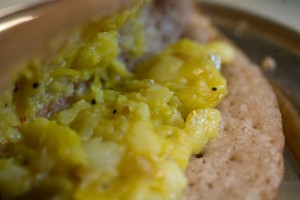I love ethnic foods from all over the globe. I consider it a real treat when i get to experience something new. Today, I decided to treat myself and went to an Indian restaurant. The smells of curries, tandoori, masala enveloped my senses and I ate heartily.
One of my favorites is dosa masala, a vegetarian dish. With several trial and error attempts, I finally perfected my recipe. I hope you can try it too.
Crispy Masala Dosa is one of the most popular among the South Indian recipes. It is a typically eaten for breakfast and is rich in carbohydrates and protein. It is considered as the staple food in the South Indian region. In the rest of the country too, Dosas are hugely popular and Udipi restaurants serving them and other South Indian foods can be found in almost every suburb.
Dosa shell: 
2 cups – Idli rice or parboiled rice
1/2 cup – Skinless split urad daal* (skinless black gram)
1/2 teaspoon – Methi seeds (Fenugreek seeds)
1/4 cup – Poha (beaten rice)*
1/4 cup – Cooked rice
1/4 teaspoon – Cooking Soda
3 to 4 teaspoon – Sugar
1 tablespoon – Salt
1 handful – Chana dal (Yellow split peas)*
* many of these items can be picked up in various ethnic food stores.
Add parboiled rice, methi, poha, cooked rice, yellow spilt peas into one large vessel containing sufficient water for soaking. Then soak urad dal in water in a separate vessel. Soak for 6-7 hours or overnight.
Then grind the contents from both the containers separately to a smooth paste adding water as required. After grinding the urad dal, add it to the main batter container and mix well. Add water as required until you get a pouring consistency.
Now add sugar, salt, cooking soda and mix well. Cover and keep aside in a warm place for at least 7 hours. During this time the batter raises and reaches approximately two and a half times the original volume. So make sure you use a big enough container for the dosa batter.
Masala Filling:
4 Potatoes, medium sized
1 to 2 Onions, medium sized long thinly sliced
12 Small green chilies, split at the center (optional)
1/4 tsp – Turmeric
Salt to taste
1/4 tsp – Mustard
1 tsp – split urad daal
1 1/4 tsp yellow split peas or lentils
½ cup of chickpeas
½ tsp – Curry powder
2 tbsp – Coriander leaves or Cilantro
1 tbsp – Ghee or additional oil
2 tbsp – Oil
Cut the potatoes each into 2 pieces with the skin intact and cook them as if you were making mashed potatoes. Once tender, peel the skin of the potato and roughly smash or squeeze them coarsely by hand and set aside.
Heat oil in large pan and add the mustard seed. When the mustard starts popping or bursting add split urad daal, chickpeas and the yellow split peas or lentils. Keep stirring for a minute and then add onion, curry, green chilies and turmeric. Sauté for around 10 minutes. Add Salt and 1/2 cup water and stir well. Add the mashed potato, coriander leaves, ghee and mix well. Now take the pan of the heat and the filling is done.
The filling is added to the dosa and wrapped like a cannoli.
Now, I like to eat the filling as a stand alone or with toasted pita or naan bread. But you can make your own determination. The cook can control the level of the spice by limiting the number of chilis to the dish. In my version, they are not added at all.

